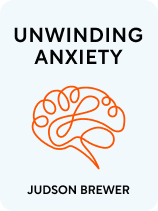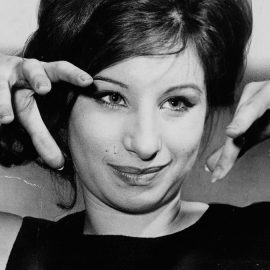

This article is an excerpt from the Shortform book guide to "Unwinding Anxiety" by Judson Brewer. Shortform has the world's best summaries and analyses of books you should be reading.
Like this article? Sign up for a free trial here.
Are you wondering how to break the cycle of anxiety? How does anxiety lead to other problems?
In Unwinding Anxiety, Dr. Judson Brewer gives practical advice for dealing with anxiety. Brewer’s guidelines for overcoming anxiety are based on his definition of anxiety as a habit loop.
Let’s look at how to break the cycle of anxiety in three steps.
Breaking the Cycle
Once we understand how anxiety functions as a behavioral cycle, we can see that the solution to anxiety is breaking the cycle that creates and reinforces it. Brewer says learning how to break the cycle of anxiety requires three steps:
- Recognize your anxious patterns as they arise.
- Pay close attention to your behaviors and their results so that you can determine whether any given behavior truly helps your situation.
- When you notice unhelpful behaviors, replace them with more useful and rewarding ones.
Be aware that these steps aren’t strictly linear. When you’re first learning to work with anxiety, you’ll need to take them in order because each step builds on the one before it: You can’t deconstruct a behavior loop (step 2) that you haven’t even noticed (step 1), and you can’t replace behaviors (step 3) until you’ve determined whether they need to be replaced (step 2). But because behavior change is an ongoing practice, you’re never really “done” with this process, and it’s completely normal (and necessary) to move back and forth between the steps.
Step #1: Recognize Your Anxious Patterns
You can’t solve a problem you haven’t noticed yet, so the first step to treating anxiety is to recognize the behavioral and thinking loops that create and result from anxiety. To do so, Brewer says, you need to practice mindfulness so that you’re more aware of your thoughts and actions.
Brewer borrows his definition of mindfulness from mindfulness proponent Jon Kabat-Zinn, who says that mindfulness means: “Paying attention, on purpose, in the present moment, non-judgementally” [sic]. Brewer distills this definition down to two components: awareness and curiosity.
Step #2: Analyze Your Behaviors and Their Results
Brewer says that one of the benefits of treating anxiety as a habit is that doing so allows us to analyze the rewards of our anxious behavior. In a habit loop, a reward is any result that reinforces the behavior. For example, if you feel anxious and eat some potato chips, you enjoy a salty snack, your body enjoys a dopamine hit as it processes the carbohydrates, and your mind (possibly) enjoys a brief respite from whatever caused the anxiety. These short-term rewards are part of the reason we get addicted to anxiety even though it has numerous long-term consequences.
Brewer argues that a key step in breaking the anxiety habit is changing the value we place on anxiety’s rewards. He suggests that if we recognize that these short-term benefits aren’t actually that fulfilling, we’ll be less apt to continue thinking and behaving anxiously. Then, if we substitute non-anxious behaviors that offer better rewards, we’ll learn to choose those behaviors over anxious ones.
Updating Your Reward Value
According to Brewer, the trick to seeing that anxiety is unrewarding is to realize that our brains often overestimate the value of anxiety-related rewards. In other words, he claims that if you pay close enough attention, you’ll notice that potato chips don’t taste that good and that generally, the more of them you eat, the less you enjoy them and the worse you feel. The problem is that the brain takes a lot of factors into account when assessing reward value, and some of these factors aren’t directly relevant to the actual quality of the reward.
For example, if you enjoy looking at Instagram posts, your brain’s Instagram reward calculation might take into account Instagram’s informational and entertainment values, as you’d expect. But it’s also taking into account:
- Your emotional associations with your friends and family who post on Instagram.
- Your attachment to other things you care about (and follow on Instagram)—hobbies, sports teams, world events, and so on.
- Any stake you might have in people seeing and liking your posts.
- All previous instances of browsing Instagram to assuage anxious feelings.
This means that when your brain is weighing whether to open Instagram (or to keep browsing for a few more minutes), it’s assessing a lot more than just the enjoyableness of the experience itself. If you don’t realize that, you might find yourself using the app when you didn’t really mean to or continuing to scroll even though you’re bored with the posts. The problem here is that your brain set a relatively high reward value for Instagram and then never bothered to reassess that value.
On the other hand, Brewer says, if you’re mindful, you can figure out how rewarding your behaviors actually are. For example, if you find yourself scrolling through Instagram when you’re anxious, simply pay attention to what that’s like. How much do you enjoy the posts? Are you really interested in peoples’ updates? And when you’re done, do you feel more or less anxious than before? Do you feel guilty for having spent your time this way?
In many cases, you might find that anxiety-driven behaviors (such as procrastination via social media, problem eating, substance use, and so on) aren’t actually very rewarding in their own right. When you look at the behavior itself and notice how it makes you feel moment by moment, you might find that you don’t even like it very much, or that you like it in much smaller doses than you thought. Realizing this makes it much easier to change unwanted behaviors.
Step #3: Use Better Rewards to Change Behaviors For Good
Brewer says that once you’ve recognized a behavior loop and mindfully assessed its reward value, the key to changing the behavior is replacing it with something more rewarding. He argues that mindfulness is, in itself, an ideal replacement behavior for three reasons:
First, it’s always available. You can be mindful regardless of your circumstances, location, or resources. You don’t need any particular item, substance, or environment to practice mindfulness.
Second, it’s inherently rewarding—more so than whatever behavior you might be trying to change. Brewer says that mindfulness feels good in its own right and that it promotes other positive feelings such as openness, creativity, and joy that are also rewarding.
Furthermore, unlike the behaviors it replaces, mindfulness’s reward value never fades. For instance, the first time you drink when you’re anxious, the alcohol might actually do a decent job of making you feel relaxed. But over time, not only will you need to drink more to get the same effect, but intoxication itself will become less rewarding as its novelty wears off.

———End of Preview———
Like what you just read? Read the rest of the world's best book summary and analysis of Judson Brewer's "Unwinding Anxiety" at Shortform.
Here's what you'll find in our full Unwinding Anxiety summary:
- How to recognize and counteract anxiety with mindfulness
- Why anxiety becomes is toxic if left untreated
- A three-step method for treating anxiety






